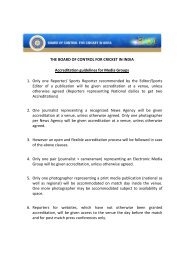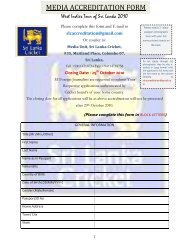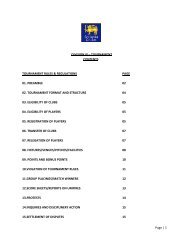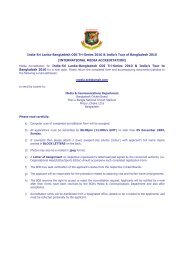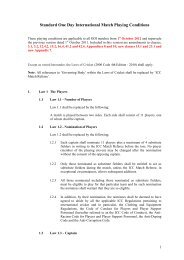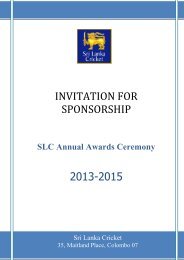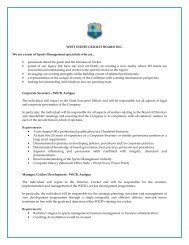Standard ODI Playing Conditions - Sri Lanka Cricket
Standard ODI Playing Conditions - Sri Lanka Cricket
Standard ODI Playing Conditions - Sri Lanka Cricket
You also want an ePaper? Increase the reach of your titles
YUMPU automatically turns print PDFs into web optimized ePapers that Google loves.
04<br />
standard ONE-day INTERNatiONAL<br />
match playing conditions<br />
iii) With regard to determining whether the ball was likely to have<br />
hit the stumps:<br />
- If a ‘not out’ decision is being reviewed, in order to report<br />
that the ball is hitting the stumps, the evidence provided by<br />
technology should show that the centre of the ball would<br />
have hit the stumps within an area demarcated by a line<br />
drawn below the lower edge of the bails and down the<br />
middle of the outer stumps.<br />
however, where the evidence shows that the ball would have<br />
hit the stumps within the demarcated area as set out above<br />
but that:<br />
• The point of impact is 300cm or more from the stumps; or<br />
• The point of impact is more than 250cm but less than<br />
300cm from the stumps and the distance between point<br />
of pitching and point of impact is less than 40cm,<br />
the original decision will stand (i.e. not out).<br />
- If an ‘out’ decision is being reviewed, in order to report that<br />
the ball is missing the stumps, the evidence of the technology<br />
should show that no part of the ball would have made<br />
contact with any part of the stumps or bails.<br />
j) in circumstances where the television technology (all or parts<br />
thereof) is not available to the third umpire or fails for whatever<br />
reason, the third umpire shall advise the on-field umpire of this<br />
fact but still provide any relevant factual information that may<br />
be ascertained from the available television replays and other<br />
technology. See also paragraph 3.5 (d).<br />
k) the on-field umpire must then make his decision based on those<br />
factual questions that were answered by the third umpire, any<br />
other factual information offered by the third umpire and his<br />
recollection and opinion of the original incident.<br />
l) the on-field umpire will reverse his decision if the nature of the<br />
supplementary information received from the third umpire leads<br />
him to conclude that his original decision was incorrect.<br />
3.4 The process for communicating the final decision<br />
a) When the on-field umpire has reached a decision, he should advise<br />
the TV director (directly or via the third umpire).<br />
b) For Player Reviews concerning potential dismissals, he should then<br />
indicate “Out” by raising his finger above his head in a normal yet<br />
prominent manner or indicate “Not Out” by the call of ‘not out’<br />
and by crossing his hands in a horizontal position side to side in<br />
front and above his waist three times (as per a ‘safe’ decision in<br />
baseball). Where the decision is a reversal of the on-field umpire’s<br />
previous decision, he should make the ‘revoke last signal’ indication<br />
immediately prior to the above.<br />
c) if the mode of dismissal is not obvious or not the same as that on<br />
which the original decision was based, then the umpire should advise<br />
the official scorers via the third umpire.<br />
4.40



